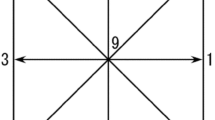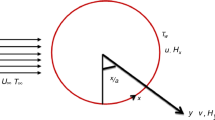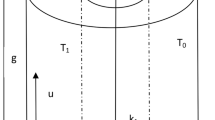Abstract
This study describes the numerical evaluation of the transient and steady state characteristics of a magnetothermal wind created by the Kelvin force inside the bore space of a super-conducting magnet. The model system designed to evaluate the present numerical computations is composed of two coaxial circular pipes with open ends. The outer pipe, acting as the cooling pipe, corresponds to the bore space of the super-conducting magnet, while the inner pipe, acting as the heating pipe, is installed inside this bore space. The vertical magnetic gradient generated in the bore space as a source of the Kelvin force was replaced by that generated by the electric current circulating within the circular electric coil. The computed results indicated that the generation direction, the flow rate, and the flow pattern of the magnetothermal wind strongly depended on the position of the circular electric coil. For instance, when the circular electric coil was placed at the lower end of the heating region, the free convection was accelerated by the Kelvin force and an upward magnetothermal wind with a maximum flow rate was created. On the other hand, when the circular electric coil was placed at the upper end of the heating region, the free convection was suppressed by the Kelvin force and a downward magnetothermal wind was created.
Similar content being viewed by others
References
Bai, B., Yabe, A., Qi, J. and Wakayama, N. I., Quantitative Analysis of Air Convection Caused by Magnetic-Fluid Coupling, AIAA Journal, 37 (1999), 1538–1543.
Berry, M. V. and Geim, A. K., Of Flying Frogs and Levitrons, European Journal of Physics, 18 (1997), 307–313.
Braithwaite, D., Beaugnon, E. and Tournier, R., Magnetically Controlled Convection in a Paramagnetic Fluid, Nature, 354 (1991), 134–136.
Gray, D. D., Huang, J. and Edwards, B. F., Two-Dimensional Magnetothermal Plumes, International Journal of Engineering Science, 39 (2001), 1837–1861.
Hirt, C. W., Nichols, B. D. and Romero, N. C., SOLA-A Numerical Solution Algorithm for Transient Fluid Flows, Los Alamos Scientific Laboratory report, (1975), LA-5852.
Kaneda, M., Tagawa, T. and Ozoe, H., Convection Induced by a Cusp-Shaped Magnetic Field for Air in a Cube Heated From Above and Cooled From Below, Journal of Heat Transfer, 124 (2002), 17–25.
Kitazawa, K., Ikezoe, Y., Uetake, H. and Hirota N., Magnetic Field Effects on Water, Air and Powders, Physica B, 294–295 (2001), 709–714.
Ozoe, H., Magnetic Convection, (2005), 139–203, Imperial College Press, London.
Tagami, M., Hamai, M., Mogi, I., Watanabe, K. and Motokawa, M., Solidification of Levitating Water in a Gradient Strong Magnetic Field, Journal of Crystal Growth, 203 (1999), 594–598.
Tagawa, T., Ozoe, H., Inoue, K., Ito, M., Sassa, K. and Asai, S., Transient Characteristics of Convection and Diffusion of Oxygen Gas in an Open Vertical Cylinder under Magnetizing and Gravitational Forces, Chemical Engineering Science, 56 (2001), 4217–4223.
Tagawa, T., Ujihara, A. and Ozoe, H., Numerical Computation for Rayleigh-Benard Convection of Water in a Magnetic Field, International Journal of Heat and Mass Transfer, 46 (2003), 4097–4104.
Taylor, C. and Morgan, K., Computational Techniques in Transient and Turbulent Flow, 2 (1981), 1–35, Pineridge Press, U.K.
Uetake, H., Hirota, N., Nakagawa, J., Ikezoe, Y. and Kitazawa, K., Thermal Convection Control by Gradient Magnetic Field, Journal of Applied Physics, 87 (2000), 6310–6312.
Author information
Authors and Affiliations
Additional information
Masato Akamatsu: He graduated from Kyushu Institute of Technology with a major in Mechanical Engineering in 1994 and received his Dr. Eng. from Kyushu University in 1999. He worked in the Department of Mechanical Engineering, Oita University as a research associate in 1999. Then, he worked in the Department of Machine Intelligence and Systems Engineering, Akita Prefectural University as a research associate since 2000. He has worked in the Department of Mechanical Systems Engineering, Yamagata University as an associate professor since 2007. He has been engaged in the study of thermal convection control of fluids with and without the electric conductivity by a magnetic field.
Mitsuo Higano: He received his M. Eng. in Mechanical Engineering in 1970 from Tohoku University. He also received his Dr. Eng. in Mechanical Engineering in 1994 from Tohoku University. After obtaining his M. Eng., he worked at the Institute of Fluid Science (later renamed the Institute of High Speed Mechanics), Tohoku University as a research associate. He became an associate professor in the Department of Machine Intelligence and Systems Engineering, Akita Prefectural University in 1999, and is currently a professor in the Science and Technology Integration Center. His research interests include Quantitative Visualization, Computational Heat Transfer and Fluid Mechanics, and the Thermophysical Property of Matter.
Rights and permissions
About this article
Cite this article
Akamatsu, M., Higano, M. Magnetothermal Wind Visualized by Numerical Computation. J Vis 10, 261–270 (2007). https://doi.org/10.1007/BF03181693
Received:
Revised:
Issue Date:
DOI: https://doi.org/10.1007/BF03181693




